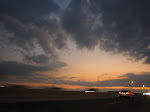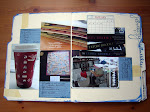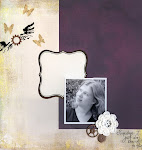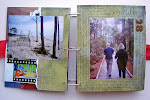Welcome back to your regularly schedule acrylic technique post! It's been a crazy couple of weeks. #3 Glue Dots: Again, the glue dots are visible. Although I have had some luck in hiding them in the pattern of patterned paper (imagine all the centers of your flowers are glue dots), then they're really hard to pick out. Again, pretty visible. The Xyron is pretty much as good as it got for "invisible". Although it's not because the Xyron adhesive is any less visible than the other adhesives, but because it is evenly applied and therefore harder to pick out. 1) Cover your adhesive with other design elements. It takes a little planning, but this is really a good "go-to" technique for acrylic. 2) Hide your adhesive in patterns or other design elements. 3) Use non-standard adhesives that are decorative in themselves like paint and Stickles. Hope you find this helpful. Let me know if you have any other recommendations of adhesives for me to try! Happy humpday!
So, I did something a little different today. I have heard alot of different opinions about which adhesive is the best to use with acrylic. And I definitely have my own opinions. So, I've done a side-by-side comparison of some of the most commonly used clear adhesives and what they look like when used on acrylic with light colored cardstock, dark colored cardstock, and patterned paper. Here are the side-by-side results:
Ok, so as I'm writing this post, I am soooo getting the desire to do this....
<<
#1, Glossy Accents:
I applied Glossy Accents three ways, starting from the left, 1) brushing it on, 2) dotting it on, and 3) swirling it on.
In all three methods you can clearly see where the adhesive is. Even with the brush on method, the brush strokes are clear. It's less noticeable when used with patterned paper. #2, Zip Dry:
#2, Zip Dry:
Again, I applied Zip Dry in three different ways, starting from the left, 1) brushing it on, 2) dotting it on, and 3) swirling it on.
Again, in all three methods, the Zip Dry is visible. Although I applied about the same amount of Zip Dry as I did Glossy Accents, not as much of the Zip Dry seems to show. This is because the Zip Dry had a tendency to dry before I could even adhere the paper, particularly using the brush on method because it is such a thin layer. Because of its tendency to dry very quickly, I got really inconsistent results. The Zip Dry shows really well where it was still wet and not so well where it was already dry. Because the Zip Dry dried in some spots before I could get the paper adhered, the paper is not adhered very well to the acrylic. Also, I ended up with alot of strings of glue (you can see these particularly well in the "dotted on" section). Before I go on....Glossy Accents and Zip Dry seem to be the two most popular acrylic adhesives. They resulted in similar visibility. Of these two, I prefer Glossy Accents, here's why:
Before I go on....Glossy Accents and Zip Dry seem to be the two most popular acrylic adhesives. They resulted in similar visibility. Of these two, I prefer Glossy Accents, here's why:
1) Glossy Accents does not have the strong solvent odor that Zip Dry has.
2) Glossy Accents does not dry as quickly, giving you a little more flexibility in placement and time.
3) Glossy Accents is water soluble, meaning you can easily wash it out of brushes, off your acrylic, and off your work surface with water. Zip Dry is not water soluble. You will need turpentine or another solvent based cleaner to remove Zip Dry.  #5 Xyron:
#5 Xyron:  #6 Glue Stick and Zig 2-Way Glue:
#6 Glue Stick and Zig 2-Way Glue: Ok, so what now. Have I ruined any hope you might have of finding an "invisible" adhesive? Well, here are my recommendations:
Ok, so what now. Have I ruined any hope you might have of finding an "invisible" adhesive? Well, here are my recommendations:
Wednesday, August 27, 2008
Acrylic Adhesives
Subscribe to:
Post Comments (Atom)











3 comments:
Hi Amanda! I had this same dilemma when I was trying to apply paper to the backside of my fragments. What worked best was using a generous amount of glossy accents onto the fragments and then laying it down (lightly) immediately onto the paper. Then using a twisting, swirling motion on the fragment, you can make sure the glossy accents have adequately spread over the entire fragment tile. This works great for smaller pieces of paper and paper embellishments, but it's not practical for larger sheets of paper - the glossy accents dries pretty quickly.
Thanks for the side-by-side comparisons! I was impressed with the xyron and will have to try it on my next acrylic album!
Deb
this is fantastic, amanda! thanks for sharing this awesome technique. and CONGRATS for having 5000 hits in just 4months! :)
This was definitely helpful, as I haven't quite braved larger acrylic pieces yet, thank you!
Post a Comment